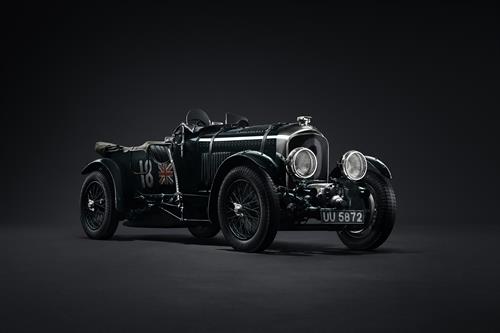One of the most thrilling and iconic cars from Bentley’s history – Sir Tim Birkin’s 1929 supercharged 4½-litre “Blower” – is to be reborn in a new series of 12 matching cars. Each is individually handcrafted by a specialist team from Bentley’s bespoking and coachwork division, Mulliner. Together, the new cars will form the world’s first pre-war race car continuation series.
Only four original ‘Team Blowers’ were built for racing by Birkin, in the late 1920s. All saw a fight to the finish on the racetracks of Europe, with the most famous car – Birkin’s own Team Car No. 2, registration UU 5872 – racing at Le Mans and playing a pivotal role in the factory Bentley Speed Six victory in 1930.
Now, using Bentley’s renowned handcraftsmanship and the very latest digital technology, the 1929 Team Blower will be the master example for 12 continuations – one for each race that the original rip-roaring fleet of four Team Blowers competed in.
The Bentley Blower Continuation Series was announced today at the Salon Privé Concours d’Elegance by Bentley’s Chairman and Chief Executive, Adrian Hallmark, who comments:
“As we continue to commemorate 100 years of Bentley, we are combining a look to our past with the very latest digital technologies and techniques to create something truly extraordinary. The four Team Blowers are the most valuable Bentleys in the world, and we know there is demand for genuine recreations that can be used, enjoyed and loved without risk to the prized originals.
‘The 12 new Blowers will not only be an homage to our heritage, they will be a celebration of the outstanding skills of our Mulliner craftspeople. This is a new challenge for Bentley, but with the incredible success of the recent restoration of our 1939 one-of-one Corniche, we wanted to go one step further and make something even more special. Twelve lucky customers will soon be able to own a unique tribute to Bentley’s history.”
Recreating the Blowers
Bentley’s own Team Blower – chassis number HB 3403 – will be disassembled to its individual components, before each part is catalogued and meticulously scanned in 3D to create a complete digital model of the entire car. Using the original 1920s moulds and tooling jigs, and traditional hand tools alongside the latest manufacturing technology, 12 sets of parts will then be created, before assembly. The 12 continuations will be identical wherever possible to the original – mechanically, aesthetically and spiritually – with only minimal hidden changes dictated by modern safety concerns. The original car will then be reassembled, with the heritage team taking the opportunity to complete a detailed inspection and sympathetic mechanical restoration where required.
It will take Mulliner approximately two years of meticulous work to complete the 12-car series. Prices will be on application.
The Iconic ‘Team Blower’
No other pre-war Bentley had an impact like the supercharged 4½-litre ‘Blower’ Bentley. While it never won an endurance race, the Blower Bentley was the outright fastest race car of the day, and counted among its fans the author Ian Fleming – who later decided that his famous fictional secret agent James Bond would drive a supercharged 4½-litre Bentley, with the often-associated rival British sports car merely the MI6 “pool car”.
The Blower Bentleys were born from a philosophy devised by Sir Tim Birkin – notable racing driver and Bentley Boy – to extract more speed from the racing Bentleys of the day. While W.O Bentley’s method was to increase engine capacity – from 3-litre, to 4½-litre, to 6½-litre – Birkin was impressed by the Roots-type supercharger developed by British engineer Amherst Villiers, which boosted the 4½’s power from 130 bhp to 240 bhp in race tune. He persuaded Bentley Chairman Woolf Barnato to sanction production of 55 supercharged 4½-litre Bentleys, with five allocated for competition. The car on Bentley’s heritage fleet – UU 5872 – is the second of the four ‘Team’ cars developed at Birkin & Co’s workshops at Welwyn Garden City with funding from wealthy heiress the Hon. Dorothy Paget.
After a formidable racing history Team Car No. 2 was sympathetically restored in the 1960s, preserving much of its original patina. Owned by Bentley Motors since 2000, it has had only minor cosmetic maintenance, and is much as Birkin would have driven it. Since then it has competed in the modern Mille Miglia five times, has driven to Le Mans on several occasions and has also appeared at the Goodwood Festival of Speed as well as the Pebble Beach Concours d’Elegance.
Mulliner – Bentley’s Bespoking and Coachbuilding Division
The Mulliner name has been intertwined with coachbuilding since 1760, when Francis Mulliner was commissioned to build carriages for the Royal Mail. In 1870, his grandson Robert formed Mulliner London Limited, and business blossomed with the advance of mechanically powered coaches. By the early 1900s they had opened a showroom in London’s prestigious Mayfair.
The 1923 Olympia Show in London saw the first collaboration between Robert’s son H.J. Mulliner and Bentley – a bespoke 3½-litre. The link between the two companies was formalised in 1959, with Mulliner becoming an official part of Bentley.
Today, the Mulliner workshop is based at the home Bentley in Crewe, where customers can personalise their own cars through collaboration with master designers and engineers. Their most recent triumph is the complete recreation of the 1939 Bentley Corniche – a Bentley concept car of the era, once thought lost to history, but now reborn thanks to the extensive and diverse range of skills present in Mulliner’s team of Master Craftsmen and Craftswomen.

















